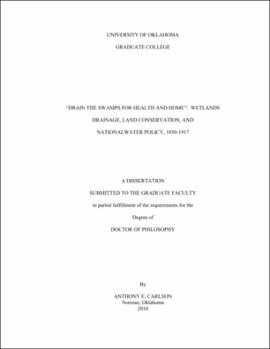| dc.contributor.advisor | Pisani, Donald J | |
| dc.creator | Carlson, Anthony Everett | |
| dc.date.accessioned | 2019-04-27T21:32:32Z | |
| dc.date.available | 2019-04-27T21:32:32Z | |
| dc.date.issued | 2010 | |
| dc.identifier | 99282049002042 | |
| dc.identifier.uri | https://hdl.handle.net/11244/318951 | |
| dc.description.abstract | Wetlands drainage is one of the oldest and commonest forms of land modification in American history. Colonists and later Americans perceived wetlands as a threat to progress and prosperity. Wetlands impeded travel, depressed property values, harbored dangerous predators, segregated otherwise arable land from cultivation, and were thought to discharge miasmas and miasmata into the atmosphere that caused a variety of febrile illnesses. In response to these fears, local communities and the national government implemented policies and created institutions to drain wetlands for health and agricultural purposes. By 1900, Americans identified wetlands drainage as a form of enlightened land stewardship that rivaled forest preservation, the protection of migratory waterfowl, western irrigation, flood control, and the regulation of grazing and mineral extraction on public lands in importance. Surface water removal was a paramount public policy objective in United States history and shaped Americans' relationship to their physical environment and one another. | |
| dc.format.extent | 334 pages | |
| dc.format.medium | application.pdf | |
| dc.language | en_US | |
| dc.relation.requires | Adobe Acrobat Reader | |
| dc.subject | Drainage--United States--History | |
| dc.subject | Wetlands--United States--History | |
| dc.subject | Wetland conservation--United States--History | |
| dc.title | "Drain the Swamps for Health and Home": Wetlands Drainage, Land Conservation, and National Water Policy, 1850-1917 | |
| dc.type | text | |
| dc.type | document | |
| dc.thesis.degree | Ph.D. | |
| ou.group | College of Arts and Sciences::Department of History | |
